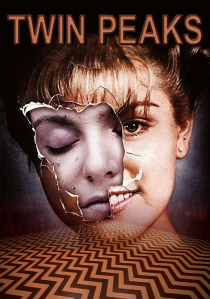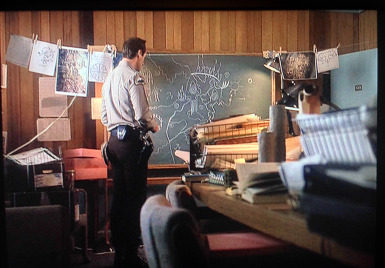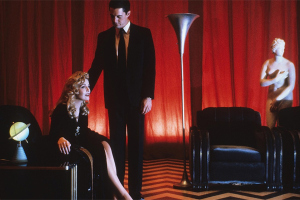Jay Dyer
2st Century Wire
“‘I learned that just beneath the surface there’s another world, and still different worlds as you dig deeper.’
– David Lynch
If you’ve ever sensed the flimsy, thin veneer of what parades itself as the good ole US of A, and felt a bit like you’ve been sold a fake, then David Lynch’s Twin Peaks is series you must see.
More like an initiatory experience than a mere television series, Twin Peaks functions as a hilariously terrifying vision of the real America lurking in the seedy underworld beneath the façade of white picket fences, much like the picturesque severed ear on the beautiful lawn in his celebrated 1986 comedic horror, Blue Velvet. Twin Peaks might even properly be titled an esoteric dark satirical soap opera. There are countless reviews, essays and analyses of Lynch and Twin Peaks, but almost all miss the complex system of symbols and hidden meanings that relate directly to high level occultism.
Before we go there, we must discuss set and setting: Twin Peaks is aptly described as quintessential Lynch. Fans often speak of scenes being “Lynchian,” but nothing stands out with that epithet better than this surrealist, neo-noir melodrama that magically captures the spirit of America itself. Differing from later Lynch focused on Hollywood (which is itself the Inland Empire), Twin Peaks is more akin to his 1990 film, Wild at Heart, in its presentation of America in miniature. Like later Lynch films, however, Twin Peaks does share its deeper occult symbology with films like Lost Highway, Mulholland Drive and Inland Empire. In this analysis, we will delve even deeper into that unique place, the subconscious dreamscape of Lynch, and decode the scenes and images many still find mystifying 25 years later.
Worth mentioning before delving into the narrative itself is Lynch’s preferred style. Part horror, part neo-noir, part comedy, part melodrama and part soap opera, the Lynch/Frost collaboration collates a vast array of Hollywood classics, from Hitchcock “doubling” to Otto Preminger’s 1944 noir classic, Laura. Parallels between the myna bird from Hitchcock’s The Birds, and the hard-hearted detective who finds himself taken with an apparently murdered Laura, abound, and Lynch intentionally includes countless parallels to sprinkle his work deriving from the Golden Age of cinema.
As we enter the world of Twin Peaks, protagonist Agent Dale Cooper (played by Kyle MacLachlan) arrives to investigate the enigmatic murder of popular high school blonde babe, Laura Palmer (played by Sheryl Lee). Based on an unsolved murder from Twin Peaks co-director and creator Mark Frost’s hometown, Laura will function as the focal point for the show’s arc. However, as Agent Cooper unravels the actual story of Laura’s demise, the truth involves a much wider conspiracy than originally conceived. With his unorthodox divinatory methods of solving crime, Cooper astounds local law enforcement with the concept of utilizing synchronicity to associate similar names with inanimate objects in a game of rock toss. This odd practice will configure Cooper as both a classic pulp detective figure along the lines of Sam Spade, but also grant a mystical side from which he will draw to peer into the psychosphere. Couliano writes, citing Eliade of the shaman in descriptive terms that capture the spirit of a Lynch work:
“Mircea Eliade defined shamanism not as religion properly speaking, but as a “technique of ecstasy,” a system of ecstatic and therapeutic methods whose purpose is to obtain contact with the parallel universe of spirits and to win their support in dealing with the affairs of a group or of an individual.” (Out of This World, pg. 38)

IMAGE: Bad Laura and her double, the good girl Maddy Ferguson.
As I commented in previous analyses, Lynch, through Cooper, is drawing on a highly complex and deeply rooted eastern notion of formal and essentialist association that extends beyond immediate space and time. The stage is thus set for Cooper to be much more than a clever detective, but rather we see the emergence of his role as an other-world traveling shaman. Later in the series, his spiritual “gifts” are noted by Native American deputy Hawk and General Briggs, where Cooper is eventually revealed to be the one who can travel to, and call, between the worlds, fulfilling the role of the magician from the series’ famed tagline below, “fire walk with me.” This is the role of the shaman I described in reference to Lost Highway, citing Levenda’s analysis:
“In Twin Peaks, it is the light in the morgue over the place where the body of Laura Palmer had been kept, and which is then visited by Mike, the one-armed man, who recites the famous poem:
“Through the darkness of futures past
The magician longs to see;
One chants out between two worlds
‘Fire walk with me.’”
There, in a strange little verse, we have the key to unlocking the mystery not only of Twin Peaks but virtually all of Lynch’s films: the suspension of normal laws of time (“futures past”) and the idea that the magician lives “between two worlds.”

Famed comparative religion scholar Ioan Couliano’s “Out of This World” chronicles the history of other-worldly planes and shamanic journeys in the same fashion Lynch presents.
The suspension of normal, linear narrative event in favor of a dreamlike, hallucinatory set of images that are taking place all over the fourth dimension is part of Lynch’s appeal as a director, and part of what makes his films so frustrating to the film goer. His realization that there are two worlds, and a place to stand between them, is what contributes to his aura as a modern, twenty-first century initiate of the Mysteries, for that is what “mystery” films are: elucidations of the core Mystery behind reality.” (Sinister Forces, Vol. 3, pg. 151).
And this forms the solution to Lost Highway, as well. The shamanic and magical elements are here in full force, as Fred is a character trapped in different psychical worlds that seem to unfold and envelop other psyches, as we will see.”
Interpreting Twin Peaks accurately involves understanding the notion of “twilight language,” or Sandhyabhasa. It is my contention that Twin Peaks should be read in this way, as if the series itself were a yogic text, and this is natural given Lynch’s (and Agent Cooper’s) preference for eastern meditation. Indian scholar Vijay Mishra comments on the ambiguous semiotic discourse involved in twilight language as follows:
“Tantric texts are often composed in an intentional language (Sandhyabhasa), a secret, dark, ambiguous language in which a state of consciousness is expressed by an erotic term and the vocabulary of mythology or cosmology is charged with Hathayogic or sexual meanings. According to Eliade…it is translated “enigmatic language” and Max Muller called it “hidden language….All the works of Sahajayana are written in the Sandhya bhasa…of light and darkness…partly light, partly darkness; some parts can be understood, while other parts cannot.” (Devotional Poetics and the Indian Sublime, pg. 221)
Cooper’s methods of reading dreams and visions and omens becomes an insight into the metaphysics of Twin Peaks, which are very much in line with the presentation here at JaysAnalysis.

Cooper utilizes a form of divination through free association and synchronicity.
From the film Twin Peaks: Fire Walk with Me, we are given the impression that Laura’s spirit has summoned Cooper from the FBI to come and investigate. Consistently through the series Cooper receives messages and clues from this spirit realm, or what might accurately be called the aether or astral realm.
As he sleeps, his higher self enters this realm and communicates with an assorted cast of shades, ranging from Laura Palmer, a young version of David Lynch, a midget known as “The Man from Another Place” (played by Michael J. Anderson), and a giant. Channeling these entities, Cooper gradually unravels the twilight language script behind the wooded Washington city, and we, the viewers, embark on the same initiatic journey of decoding the script as Cooper.
From reading the simulacra within simulacra, Cooper begins to discover the secret of Twin Peaks involves the black market, where town tycoon Ben Horne organizes and controls local prostitution, gambling and drug running through his private club, One Eyed Jacks. The nomenclature here is significant, as town oddball Nadine only has one functioning eye, and later dissociates to a younger version of herself, as well as possessing excessive strength. Nadine functions as a comic foil to Laura, but her initial psychosis and dissociation to a different persona is a key to Laura Palmer, as we will see.
One Eyed Jack’s the locale of Ben Horne’s (played by Richard Beymer) control of vice, with connections to larger criminal mafia organizations personified in the characters of the Renault brothers. Horne’s network includes the legitimate face of several businesses in town, from the Great Northern Hotel, to Horne’s Department Store, while secretly there is a nearby casino and cathouse. While not directly involved in the occult, Horne is the archetypal 80s businessman, who had no direct involvement in the murder of Laura Palmer. While briefly accused of the murder, the reality surrounding Laura is much darker and complex.
Cooper discovers through the eventual disclosure of Laura’s secret diary that she had been raped since age 12 by her father, Leland (played by Ray Wise) and a spirit named “Bob.” Bob is a former killer who has become a demon in the afterlife and possesses individuals such as Leland, and later Windom Earle, to commit crimes such as pedophilia and sacrificial murder. I have detailed the reality of this frightening process of dividing the psyche through trauma here, and for a comprehensive understanding of what has happened to both Laura and Leland, I recommend reading that essay. Concerning alters and the split psyche, I noted:
“Considering specifically the fragmentation of the psyche, the extreme versions appear in the diagnoses of MPD/DID and schizophrenia, with the unifying factor being sever trauma, often in childhood. Trauma later in life appears in “Post-traumatic Stress Disorder,” with the same patterns of dissociation and fragmentation and psychosis often appearing. What is almost never discussed, though the evidence surfaces daily, particularly with former military and pop star circles are the realities of ritual abuse. Having read several works on the subject, ritual abuse appears frequently in these cases, yet goes unmentioned in the mainstream. This tide appears to be changing with the case of Jimmy Savile and his network, as even the mainstream media has been forced to report on the avalanche of officials involved in occultic and ritual abuse.”

Black market control of the vices through Ben Horne’s One Eyed Jack’s. Jack is a perennial term for the devil, and the single eye symbolism mirrors that of Nadine.
Not only is there a black market of prostitution and the luring of young girls into porn, there is a cult that exists amongst Twin Peaks’ elite that formerly met in secret for ritual magick ceremonies. As the thread unravels, the spirit of Bob serves as the foot soldier for the Man from Another Place, organizing an occult marriage ceremony for the girls offered by Leland and other cult participants. Starting with drugs and porn, the girls are lured into prostitution and even hints of snuff films emerge.
Behind the cult is the real dark power behind Twin Peaks, the Black Lodge. In-between worlds, the Black Lodge bears a striking resemblance to irregular forms of masonry, known as Black Lodges, where dark arts are performed. The Black Lodge is also mentioned in Crowley’s novel, Moonchild, and the reports of Lynch asking his actors to speak and walk in reverse for filming the astral scenes in the lodge may have Crowleyan undertones, as well. All of this is told in striking detail in Twin Peaks, as Cooper’s visions demonstrate a human sacrificial component. In other words, Bob is a demonic force subservient to the Man from Another Place, whose lust for “fun” involves rape, pedophilia and murder. Also consistent in the narrative is old men who have their way with young girls, hearkening to the pedophilic.
In possessing individuals for the purpose of carrying out these acts, Bob captures the pain and misery stored in the “blood” of his victims and pours them out as a sacrificial offering to the Man from Another Place. In perennial demonology, this concept has many precedents, as the maleficent spirits feed on the pain and misery of the victims, parasitically.
Writer Justine Smith at SoundandSight.com comments from an aesthetic perspective:
“Then, of course we have Bob. For those unaware, the town of Twin Peaks is similarly populated by a spirit lodge that travels or is somehow engaged by electricity. One of its members, perhaps its leader is Bob, who menaces Laura throughout her life. She claims that he has raped her since she was twelve and is similarly violent. In this scene he is not only a stark contrast to the pink-childlike bedroom, but he is searching for her hidden diary. The fact that he mirrors her reaction is another mode of doubling commonly found in surrealist work, it suggests a deep connection between them, however unwilling. Finally, we have the end of the scene where Laura’s father exits the house. Having already entered that space we are fairly certain that he wasn’t there before. Is Laura’s father and Bob one and the same?”

The Garmonbozia/cream corn is the “food” of the pain and misery of the ritual sacrifice.
The answer is yes to Smith’s question. Specifically in the case of Laura, we find her youthful trauma from Bob/Leland has caused her to psyche to split into alters. This is revealed in the show explicitly, and more clearly in the film, where Laura demonstrates a duplicity of good girl/bad girl, detailing in her diary the trauma she was unable to cope with from her father’s own personality splits. Leland, just like Laura, was subject to a dual personality, with Bob eventually taking possession.
This is strikingly revealed in the driving scene in the feature film, where Leland encounters Gerard/Mike wearing the cult ring, functioning as a “trigger” for Laura and Leland to dissociate. Not only was Laura lured into the exploitative field of prostitution, she had been subject to ritual abuse. In this regard, the symbology of the ring suggests both the goat and the demonic, with inverted horns, as well as a ring, which in another sense is a group or cabal. It also displays the different planes of existence and the portal between the two peaks, in a three-tiered sense of White Lodge, earth, and Black Lodge.
What almost all researchers have missed is the crucial imagery at the police station, where in the background Cooper and Sheriff Harry Truman have pieced together ritual magick sigils. Presumably connected to the crime scenes and former FBI Agent turned psychopath, Windom Earle, the ritual magick sigils are explained in a video of Earle describing tapping into the left-handed path power of the dark side, through the Black Lodge.
The sigils in Twin Peaks are in fact sigils from Goetia, or the Lesser Key of Solomon, which specifically relate to the invocation of demons. Scorched engine oil throughout the series is a reference to the oil sludge found at Galstonbury Grove, the site of the forest portal which includes a reference to Arthurian mythology.

Symbolic sigils from the Goetia for the invocation of demons.
Earle arrives to capitalize on the dark forces in Twin Peaks, seeking the portal to the Lodge in the woods. Hovering over a pool of black, viscous oil, the portal is the site of ancient ritual practice, where gods and demigods are invoked. Lynch seems to be saying here that America is a land of primeval fallen forces that rule our present reality from just behind the veil. This is also the significance of the consistent red veil imagery, accompanying any entrance to the Black Lodge, and the planetary and astrological conjunctions that determine the opening of the portals to the next world. “Fear,” Cooper says, “opens the door to the Black Lodge, and love the doorway to the White.”
Also revealed in this association of dubious characters is Major Briggs, a military mystic whose belief in the supernatural leads to classified connections with Project Blue Book, and the military’s UFO research. In reality, Project Blue Book was a cover story for advanced technological testing of aircraft, yet even here we have a curious association, as Major Briggs’ classified work involves occult research. Briggs seems to be an approximation of the kind of real programs Jon Ronson describes in his Men Who Stare at Goats, where high level military and special forces soldiers participated in occult activities through the First Earth Battalion.
Also relevant are the recent stories of high level ritual occultism and Satanism involving the Presidio and U.S. military elite. With the associations of high level military, ceremonial magick and ceremonies conducted on the west coast in the wooded groves, Bohemian Grove comes to mind, since one of the more famous taglines for the show is “The owls are not what they appear.” Lynch seems to be hinting that the real power structure in the soap opera charade that is America is actually subservient to dark forces beyond our plane of existence. Subservient to the demonic, the hypocritical face the establishment puts forward to cover the nefarious mirrors the dual level of reality in the world of Twin Peaks, and the spirit world of the Black Lodge that undergirds it.
As Earle attempts to concoct his own ritual by sacrificing Cooper’s love, Annie (played by Heather Graham), Earle specifies that it must be done in the Grove in the magick circle. Entering the circle leads to the aether, where symbolically the death of the Queen fulfills Earle’s simulacrum of utilizing playing cards. The playing cards also hearken back to One Eyed Jack’s, where fortune and fate are personified in the series as elemental spiritual forces of nature. This focus on the elemental spirits is the reason for the Log Lady, whose sphinx-like intros to the show provide consistent clues to the overall narrative.
The Log Lady plays a minor role, but her comments on synchronicity, symbolism, and clues that point to forces of nature (Logs are wood, and thus the association with the hotel and the forest). In the background of Twin Peaks we thus have a mix of the elements of the classic world: air, earth, fire, water and aether. This elemental focus explains why Josie is trapped in the wood of the Great Northern Hotel, while others meet their demise in direct association with fire or burning exhaust and oil (Laura’s death). In the ancient world, and equally true of the ancient far east, nature was not a collection of chaotic atoms bouncing around, but a vivid landscape populated by countless spirits, angels and demons. It is this kind of world Lynch wants to be the backdrop for Twin Peaks.

The mystical toponomy of the land is laid out well in this graphic, where we see the portal in the midst of the 3-tiered planes of the lodges and earth.
The infamous climax of the series features a Cooper who has lost his way through fear, with the real Cooper trapped in the Black Lodge, and Bob possessing Cooper’s body. Cooper’s curiosity and desire for knowledge of the beyond, and in particular the dark side, would lead to his demise in much the same way as Fred Madison in Lynch’s Lost Highway. Where the series began, with the possession of an initially good man, the series ends, with Cooper as a vessel of evil. What I described of Madison in Lost Highway is relevant in regard to Agent Dale Cooper:
“Lost Highway is therefore a non-linear, Neo-noir occult psycho-drama that looks at the dark side of the Hollywood underworld, where mafia, porn, crime and the occult are interwoven into a story about one man’s psychic journey down a lost highway of his own stream of consciousness and thought. As the viewer travels with Fred Madison down this road, we are brought back to the very point he began, and the cycle starts again. Packed with dualism, illusion and mystery, Lost Highway is about life and the dark side of our own inner underworld, the subconscious, which Lynch mystically links to others.”
If we fail to realize the reality of these evils, such as possession and the mysteries of the subconscious, are we liable to be trapped like Fred in our own madness? His name itself is a clue – “Madison,” symbolizing his descent into madness, as “Alice,” Renee’s alter, brings to mind Alice in Wonderland and alternate worlds and personalities. Was Alice a victim of mind control like Fred, or were they both willing accomplices of evil? Will the obsession with the Hollywood celluloid videodrome and its cousin, the now omnipresent surveillance society, bring us truth, or more likely a descent into madness, depersonalization and dissociation like Fred? Either way, Lynch is forcing us to examine that at base, reality and the psyche are still mysteries to be decoded.”
In these series finale’s strange sequence, Cooper discovers bob has possessed Earle and has organized the last round of murders. Earle tries to steal Cooper’s soul, but Bob steps in to claim his rights on Earle’s soul. Cooper confronts the his unconscious shade self as well as facing up to his responsibility for past deaths. Cooper ends up trapped with Annie and Laura in the Black Lodge as a demonic Bob/Cooper takes possession of Cooper’s “vessel.” Worth noting here is that in the feature film, Laura’s initial journeys into the dreamscape/astral realm result in an encounter with Annie, who says she is “with Laura and Agent Cooper.” And as was the case with Mulholland Drive, electrical phenomena and static charges tend to accompany the manifestation of other-worldly spirits. The Black Lodge members appear to travel through electricity, and manifest in physical form like the Cowboy in Mulholland.
In conclusion, the return of Twin Peaks seems to have even been predicted through Laura in the Black Lodge 25 years ago. Amazingly, Laura tells an aged Cooper “I’ll see you again in 25 years,” hinting that it would return. With the recent announcements of Showtime picking up the reboot, we can expect an even deeper foray into the unconscious – both of Laura and Cooper. Whether the show returns or not, with the original series and film, we have an amazingly precise window into the real America, a land haunted by the primal, elemental spirits of the past, and controlled by a cult that adheres to these ancient beliefs. The American power elite really are like Ben Horne, subservient to preternatural forces they cannot control, and behind this veil of obscurity lies an occult elite, whose power seems to derive from a Black Lodge.
“I’ll see you again in 25 years.”
21WIRE contributor and author Jay Dyer is commentator on media, art, philosophy and culture. This article and many others, along with Jay’s podcast archive can be found on his blog Jay’s Analysis.
READ MORE HOLLYWOOD NEWS AT: 21st Century Wire Hollywood Files
–




















